In this week’s eSkeptic:
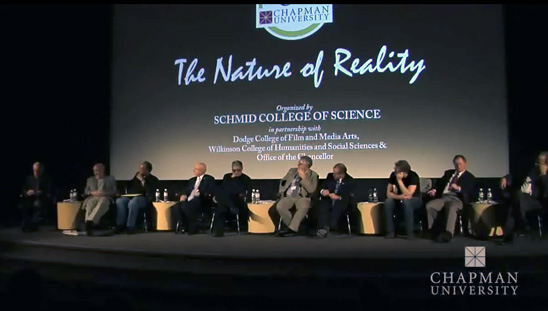
A Debate on The Nature of Reality
now available FREE on iTunes or YouTube
Is there an ultimate reality? And if so, can it be accounted for by science? The panelists include: Deepak Chopra, M.D., Menas Kafatos, Ph.D., Bill Wright, Ph.D., Jim Walsh, Stuart Hameroff, M.D., Leonard Mlodinow, Ph.D., Daniele Struppa, Ph.D., Henry Stapp, Ph.D., Carmichael Press, Ph.D., and Michael Shermer, Ph.D. This video recording is presented by Chapman University and is available free on iTunes or YouTube.

The Humanist Approach to Happiness
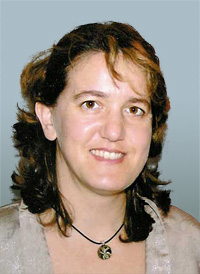
In 1765, the author of an anonymous article in a French Enlightenment periodical spoke of “The general love of humanity…a virtue hitherto quite nameless among us, and which we will venture to call ‘humanism’, for the time has come to create a word for such a beautiful and necessary thing.”
In this episode of Skepticality, Swoopy speaks with author and Humanist Jennifer Hancock about her book The Humanist Approach to Happiness. The book is a practical guide to living an ethical, compassionate and happy life, and outlines critical thinking and common sense human solutions to everyday human problems.
About this week’s feature article
In this week’s eSkeptic, Anondah Saide reviews the book Paranormal America: Ghost Encounters, UFO Sightings, Bigfoot Hunts, and Other Curiosities in Religion and Culture by Christopher D. Bader, F. Carson Mencken, and Joseph O. Baker.
Anondah Saide is a graduate student at Claremont Graduate University in the School of Educational Studies and works in the offices of Admission and Career Management of CGU. She is academically interested in the interplay between formal higher education and belief, as well as the factors (sociologically, psychologically, biologically, etc.) that specifically lead to belief in supernatural claims and the consequences (good or bad) of those beliefs.
SUBSCRIBE to Skeptic magazine for more great articles like this one.
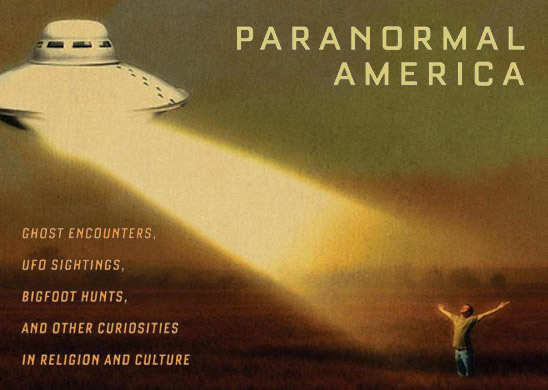
Superstition in the U.S.
a book review by Anondah Saide
In their recently published book Paranormal America, Christopher Bader, Carson Mencken, and Joseph Baker provide informationally rich narratives and a thorough account of the “what” and “who” regarding paranormal beliefs. With their well-balanced methodology (both qualitative and quantitative data) they provide a useful introduction to and overview of the role of paranormal beliefs in individual lives. Unfortunately, they take a mostly descriptive approach, and their overly cautious attempts to legitimize paranormal believers are sometimes exasperating. It may be normal to believe in the paranormal—in the sense that belief is widespread—but that does not mean that there aren’t negative sociological and psychological consequences associated with belief.
Through a sociological lens, the authors use this book to disseminate their research on: (1) what is paranormal, (2) how belief in the paranormal manifests in the lives of believers, (3) the trends in who subscribes to paranormal claims (e.g., 67% of U.S. adults subscribe to at least one and men are more likely to believe in UFOs), and (4) the differences between paranormal and religious beliefs. In addition, the authors share stories of their fieldwork experiences and the different paranormal subcultures they came into contact with along the way. The chapters in Paranormal America are a quick read but not always well labeled or organized; for example, the chapter that discusses the compatibility between religious and paranormal beliefs could have been placed much earlier in the book.
The information used to achieve the authors’ goals derive from quantitative data generated by the prestigious Baylor Religion Survey and qualitative data collected through years of fieldwork. The authors share their experiences ghost hunting, attending psychic conventions and UFO support groups, and tracking Bigfoot. The Baylor Religion Survey is one of the most comprehensive tools used for measuring belief in the supernatural. It not only measures what individuals believe, but what activities (e.g., how often they attend religious ceremonies, what phenomena they research, etc.) they engage in, and the details of their demographic characteristics. Bader, Mencken and Baker include an abundance of very useful charts and graphs in Paranormal America to give the reader illustrations of the trends of belief. They compare everything from paranormal beliefs and political views to the compatibility of different supernatural claims.
This book was written for the layperson interested in a general view of the prevalence of belief in paranormal phenomena in American society along with the subcultures that have been created in response to those beliefs.
The authors helpfully provide charts that display the demographic indicators for certain beliefs by level of importance. For example, the most powerful demographic determinants (in order of importance) according to the authors’ findings for the interest in “monsters” are: being young, male, having a low income, lower church attendance, and being a religious nonliteralist. It is important to note that this book was written for the layperson interested in a general view of the prevalence of belief in paranormal phenomena in American society along with the subcultures that have been created in response to those beliefs. As sociologists, the authors make it clear from the beginning that they are first and foremost concerned with the lives of paranormal believers and not the validity of paranormal claims. Any reader can appreciate their transparency of purpose, as well as their honestly regarding the difficulty that comes with trying to produce generalizable data.
For readers interested in why individuals subscribe to paranormal claims, the theories provided by the authors weren’t substantial (again, the authors were more descriptive and less theoretical) nor do they add to the existing literature. Some of the hypotheses discussed by the authors to explain paranormal beliefs include: deviance, the marginality/locus of control hypothesis, the small step hypothesis, and socio-economic status. All of these can be found in the academic literature on paranormal beliefs. One of the central premises of theories of deviance suggests that individuals diverge from the norms of society because they lack traditional stakes in conformity (e.g., marriage, involvement in conventional social activities, etc.). Paranormal beliefs are not treated as normative in the same way religious and other beliefs are (e.g., there isn’t a paranormal studies major at colleges and universities); therefore, when discussing deviance, paranormal beliefs would be treated as outside societal norms.
The marginality hypothesis suggests that individuals who are marginalized (e.g., lacking in resources) will be more likely to adopt supernatural explanations or beliefs in order to feel that they have more control over their lives (i.e., the belief that you can make things happen by just thinking about it). The small-step hypothesis suggests that individuals who already hold a belief in a supernatural phenomenon (e.g., religion) will be more likely to adopt another. An interesting suggestion the authors make is that belief in the paranormal may be a luxury of the wealthy. They hypothesize this because they found that the individuals who took part in paranormal activities had higher incomes (e.g., Bigfoot hunters). The reader should be skeptical of this hypothesis because it may be that individuals with lower incomes would like to take part but do not feel that they have the resources to do so. In this example, socioeconomic status may be a proxy for behavior but not belief.
A particular concern with this book is that the authors’ focus much energy on the experiences of the most extreme paranormal believers. I say “extreme” because the people they discuss in the book are not representative of the average paranormal believer. Each of the individuals they discuss would be rated as high-level believer because they engage in social activities that surround their beliefs. An issue that may arise from sharing the experiences of the most devout believers is the perpetuation of the stereotypical image of a paranormal believer. In other words, someone may think UFOs could exist but the average believer who might check a box on a survey indicating such belief probably would not attend a support group for alien abductees.
Another concern with the book results from the authors’ reluctance to share anything about paranormal believers that would shed a negative light on them. This brings to me the question of, “is Laura nuts?” Bader, Mencken, and Baker bring up a woman by the name of Laura several times throughout their book. They use her as an example of a paranormal generalist—someone who believes in many paranormal phenomena simultaneously (e.g., UFOs, ghosts, Bigfoot, astrology, psychic powers, and Atlantis). The authors share Laura’s stories of being saved by guardian angles, her past lives (including one where she was friends with Jesus), and her trips on a spaceship where she was taught to be a healer. Readers should be skeptical when they come across areas of the book where the authors make assertions about paranormal believers without providing evidence to support their claim; as they did with this declaration, “paranormal generalists [such as Laura]…are not dangerous or mentally ill, they simply live in a different cultural universe than the rest of us” (p. 157). The authors’ do not provide supporting evidence for Laura’s mental stability; but more importantly, they just do not talk about the other psychological and evolutionary factors (e.g., personal characteristics, genetics, errors in cognition, etc.) in belief. The book is insufficient without an interdisciplinary discussion. In addition, the authors do acknowledge the social (latent) consequences for belief in the paranormal.
Such an orientation might have worked if the authors stuck to being descriptive, but they didn’t. They made judgment calls on the mental, social and emotional states of believers, something that cannot be done without incorporating the work of other academic disciplines. Understanding the demographic predictors of paranormal claims and their relationship to other beliefs (e.g., religious) is important for an overall view of belief in paranormal phenomena. The graphs of data from the Baylor Religion Survey provide a broad perspective of the level of belief among U.S. citizens. The authors’ provide great information on demographic/sociocultural factors but that leaves an incomplete story of belief in the paranormal. Readers must keep in mind that this was written from a sociological viewpoint exclusively. I would not call this a comprehensive literature review of the research on paranormalism because that would have required Bader, Mencken and Baker to include the research and approaches to the subject from a number of other academic disciplines. All in all, this book is a good read for the layperson. It’s filled with interesting tidbits about the level of belief in the United States and side stories about the lives of the most ardent believers.
Skeptical perspectives on pseudoscience and the paranormal…
-
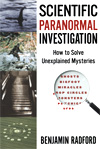 Scientific Paranormal Investigation: How to Solve Unexplained Mysteries
Scientific Paranormal Investigation: How to Solve Unexplained Mysteries
by Benjamin Radford
-
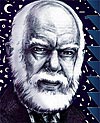 Pseudoscience & the Paranormal
Pseudoscience & the Paranormal
by James Randi
-
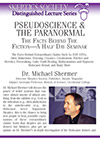 Pseudoscience and the Paranormal: The Facts Behind The Fiction (A Half Day Seminar)
Pseudoscience and the Paranormal: The Facts Behind The Fiction (A Half Day Seminar)
by Dr. Michael Shermer
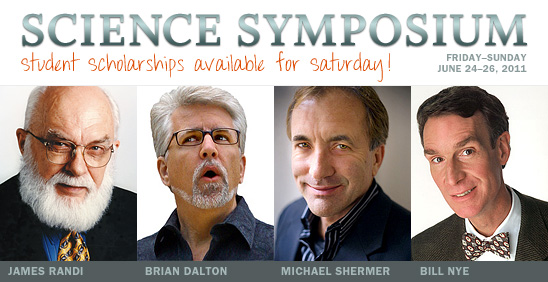
Everyone Welcome
Don’t miss this rare opportunity to hear four of the world’s leading Skeptics discuss their experiences fighting irrationality and promoting science (and what you can do to help)!
Student Scholarships
Full-time college or high school students can apply for a scholarship to attend the Symposium on Saturday, June 25, 2011. Breakfast, lunch and dinner are included; travel and lodging are not included. For high school student scholarship winners, we’ll also cover the entry fee for one chaperone per group of ten students.
Discount Host Hotel Rate ends May 22
There are a limited number of rooms available at our special conference rate. Ask for the “Skeptics Society 2011 rate” when you call 800-937-8461 for reservations. Cut-off date for the special rate is May 22, 2011.

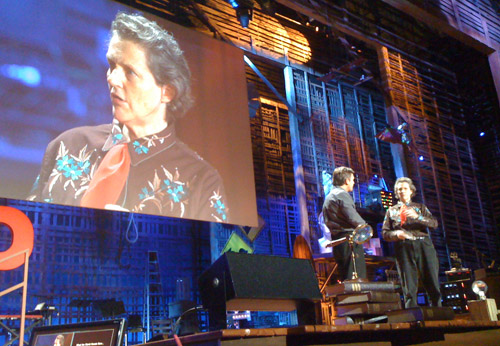
This week’s Mystery Photo: Who is this remarkable woman?
Solution to last week’s Mystery Photo
The Mystery Photo from May 4th is the grassy knoll in Dealey Plaza, home of conspiracy central for all things JFK.
We will reveal the answer to this week’s Mystery Photo in next week’s eSkeptic.

NEW ON MICHAELSHERMER.COM
Does new research prove paranormal precognition
or normal postcognition?
Psi, or the paranormal, denotes anomalous psychological effects that are currently unexplained by normal causes. Historically such phenomena eventually are either accounted for by normal means, or else they disappear under controlled conditions. But now renowned psychologist Daryl J. Bem claims experimental proof of precognition (conscious cognitive awareness) and premonition (a!ective apprehension) “of a future event that could not otherwise be anticipated through any known inferential process.” Does this new research prove paranormal precognition or normal postcognition? Michael Shermer weighs in on the matter in this week’s Skepticblog.









